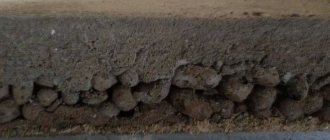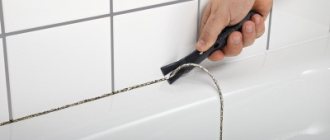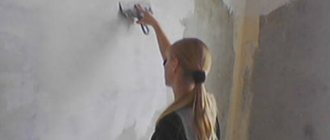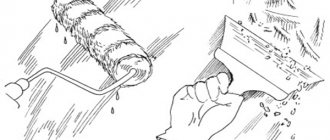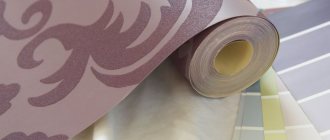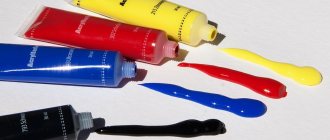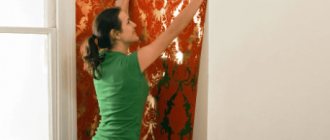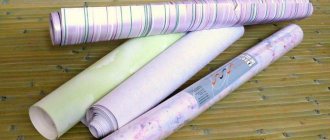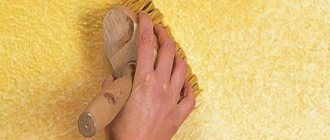19948 1 6
Icer October 9, 2016Specialization: master in the construction of plasterboard structures, finishing work and laying floor coverings. Installation of door and window units, finishing of facades, installation of electrical, plumbing and heating - I can give detailed advice on all types of work.
People often ask me how to remove wallpaper from drywall without damaging it. In fact, if everyone listened to competent advice and puttyed the surface completely, then this problem would not arise at all. But many listen to the recommendations of would-be craftsmen and only putty the seams; as a result, when the time comes to change the wallpaper, problems arise that negate all the savings on finishing.
In our article we will look at how to deal with the consequences of a short-sighted decision to glue wallpaper to drywall and keep the surface intact when removing the old coating.
In the photo: in order not to worry about removing wallpaper and not ruining drywall, you need to know a few little tricks
How and why to remove old wallpaper
A spatula is an indispensable tool for removing old wallpaper
. There are four main ways in which old wallpaper is removed from walls.
- The surface is moistened with water (using a sponge, spray bottle, broom, etc.), and then the swollen wallpaper is removed.
- Using special solutions will greatly simplify the process, but you will have to spend additional money.
- Before removing old wallpaper from drywall, you can pierce it with a special needle roller and then soak it.
- The coating is scratched with a special device and then removed from the wall.
All these examples are general, and for each type of wallpaper a different method should be chosen. The above options give an idea of how to tear wallpaper off drywall, but the question of the need for such actions remains open. Not everyone understands why such a fuss. If you just need to hang new wallpaper, then why not do it on top of the old ones?
Since the wallpaper will be glued to the glue, it will moisten (there is always water in the glue) the previous layer. This can lead to it getting wet and peeling off in certain places. This defect cannot be corrected.
If the first layer of wallpaper was pasted with some kind of defect, then it will only intensify when pasting the second layer. Also, over the years, fungus or mold may have appeared on the wall, and you should get rid of them.
The aesthetic component is also an important option. Wallpaper pasted onto wallpaper doesn't look very nice. And the choice of color is not very wide, because you need to take care that the color of the first coating does not protrude through the second.
Workflow Options
I will tell you only about those methods that I have tried myself, maybe if you know other effective solutions, tell the readers in the comments. Each of the options is good for a certain situation and for a certain type of wallpaper, so I advise you to first read the entire review and only then make a decision, and not read a little and immediately run to try this or that method.
But first of all, I want to advise you to remove the wallpaper without additional operations. Sometimes the adhesive composition does not hold them very tightly, and the work can be completed with little sacrifice, although such luck does not happen often.
Sometimes wallpaper comes off easily and without additional operations
Method No. 1 - soaking the surface
This is the simplest option that is suitable for ordinary paper wallpaper. To work we need the following:
- A container with warm water and a sponge for applying it;
- You should not use a spatula, or preferably two of different widths, to separate the wallpaper; you should not use a scraper, as it can damage the drywall coating.
As practice shows, it is best to remove wallpaper from drywall with a spatula.
Now let's figure out how to remove wallpaper from drywall:
- First you need to wet the surface with warm water and a sponge. Here it is important not to overdo it and not to wet the base too much, so as not to damage the protective layer of drywall . To do this, you need to move the sponge from top to bottom in order, so you will moisten the material and remove excess water from the surface, preventing it from becoming waterlogged;
The amount of water should not be excessive
- Next, you need to wait 5-10 minutes and you can start removing the coating. Paper wallpaper comes off in pieces, so you will have to spend a lot of time tearing off small pieces of material with a spatula;
Paper wallpaper lags very, very poorly
- If the material is not soaked at one time or pieces of wallpaper remain in certain areas, then the treatment must be repeated. Do not moisten the entire wall at once; it is much wiser to moisten the surface in parts as you remove the old wallpaper.
If you have vinyl wallpaper, then soaking it will be much worse; in order to thoroughly moisten the material and the adhesive composition underneath, you will have to slightly modify the technology:
- To prevent moisture from draining from the surface and penetrate it better, you need to add wallpaper glue to the water (about a third to a quarter of the norm). That is, you need to prepare the composition for soaking in advance, this will significantly simplify and speed up the work;
The composition must be liquid for good penetration into the material
- Application is carried out in the same way as in the option above, but due to the dense structure, processing 2 or even three times may be necessary. It all depends on the quality of the wallpaper; the denser it is, the longer it will take to get wet. It is worth moistening the wallpaper in rows, moisten each sheet from top to bottom, this is important;
- Next, you just need to make an incision with a construction knife at the junction of the covering and the ceiling plinth and carefully pry off the edge of the wallpaper sheet with a spatula. Vinyl wallpaper has a very reliable base, so it comes off as a single piece; you just need to pull the sheet and it will come off the wall in one piece - much easier and faster than the paper version;
Vinyl wallpaper comes off very easily, the main thing is that it is well saturated with moisture
- If, after removing the main part, pieces of the wallpaper base remain on the drywall, then you need to moisten those places and finish the work using a spatula.
Method No. 2 - water and mechanical treatment
This option is suitable for non-woven wallpaper and washable coverings; these options absorb moisture very poorly, so you are unlikely to cope without prior preparation. Vinyl options can be removed in the same way; although they get wet better, if you work using this technology, the process will speed up.
Before removing wallpaper from drywall, we will need to gather the following set of materials and tools.
This is what the working part of an unusual tool called a wallpaper tiger looks like
| What do you need | Description |
| Wallpaper tiger | This is the name of a special device, in the lower part of which there are toothed rollers, which, when moving, pierce the moisture-proof coating of the wallpaper, thereby preparing the surface for moisture. The configuration of the tool may differ, it is important that it is a wallpaper tiger and not a toothed roller or something else |
| Sponge or roller | You can soak the surface with either a sponge or a roller. Take what you have on hand, or purchase the option that is more convenient to work in your case. Naturally, you should also have a convenient container with warm, clean water on hand. |
| Spatula and construction knife | Using a spatula, we will pry up the edges of the sheets, remove individual remaining sections and help the coating separate where it is poorly wet. A knife is necessary for making cuts in the wallpaper in separate places to simplify their separation from the drywall |
Do not use toothed rollers, knives or other devices to cut through wallpaper. You can damage not only the coating, but also the base of the drywall and ruin all the walls. In our case, we need a wallpaper tiger that carefully breaks through the top layer.
A wallpaper knife will allow you to cut the coating in the right places to make it easier to remove.
The work instructions consist of the following steps:
As you can see, the workflow diagram is not complicated
- First of all, you need to treat the surface with a wallpaper tiger; to do this, take the tool and move it in a chaotic manner over the entire surface . Do not press the device too hard to avoid damaging the surface. The more times you walk over the wallpaper, the faster it will get wet, so try to ensure that the entire surface is treated evenly;
The wallpaper tiger penetrates the moisture-proof coating, helping moisture penetrate the adhesive layer
- Treatment with water is carried out in the same way as in the case described above; you need to carefully, but without excess, distribute the moisture using a roller or sponge. If the glue does not soften at one time, then you need to repeat it one or two more times - until the coating begins to move away from the wall. There is no need to rush, it is better to process the wallpaper again and then remove it easily and efficiently;
Moisture should thoroughly saturate the base of the wallpaper
- When the base is wet, you can start removing the wallpaper; personally, for me, they almost fell off the wall, as soon as you cut it from the top or bottom and pull it towards you. When you pull, do not be too zealous; if the canvas is holding somewhere, you can help yourself with a spatula or wet certain areas again;
Thick wallpaper is separated in whole sheets
- If there are pieces of wallpaper left in certain areas, they must be carefully moistened and removed after 10-15 minutes using a spatula . It is important to work carefully here so as not to damage the paper coating of the plasterboard sheets.
If you have non-woven wallpaper, then only the top layer will be separated from it, and the base will remain on the wall. There is no need to remove it - this is an excellent basis, both for new wallpaper and for applying putty.
When removing non-woven wallpaper, its base remains on the wall
Method No. 3 - using special tools
Water cannot always moisten the adhesive layer under wet wallpaper, so you can use a special wallpaper remover to help you, in our case it will be “Methylane”, the price of a 500 ml bottle costs about 300 rubles and is enough for about 200 square meters of coverage . Compositions of this type allow you to carefully and accurately remove the coating from drywall without damaging the finishing material itself.
Special tools greatly simplify the process
Let's figure out how to remove old wallpaper from drywall using the compositions described above. The technology combines all the options described above:
- To begin with, it is advisable to walk over the surface with a wallpaper tiger, this will simplify the penetration of the composition and speed up its action;
- Next you need to prepare the product, all proportions are indicated in the instructions on the package. You should not add too much so as not to damage the surface. You must work with gloves and prevent the composition from getting into your eyes and mucous membranes;
- The surface is treated with the finished product and left for 15-20 minutes, this is exactly how long the composition needs to soften the adhesive layer;
- Lastly, using a knife, spatula and hands, the coating is removed from the surface, and most often the wallpaper comes off in whole sheets.
Vinyl wallpaper can be removed much better than paper wallpaper after treatment with the composition.
Don't listen to the smart guys who say that soaking will damage the drywall and it's better to just tear the wallpaper off the walls. If the glue holds well, and on such walls it most often does, then you will not only tear off the protective layer from the sheets, but you can also damage the putty on the seams. Below is the result of the work without preparation, so that you can see with your own eyes what the advice of pseudo-experts leads to.
This is what happens if you just try to peel wallpaper off drywall
Method number 4 - using a wallpaper steamer
When removing old coatings, professional specialists use a special tool called a steamer, which is equipment powered by a household electrical network and consisting of a steam generator and a special working part connected to the main unit through a hose. It’s not worth buying such a device specifically because of its considerable cost, but in many cities you can rent it.
This is what a professional tool for removing all types of wallpaper looks like
As for the work process, you can do it yourself, but bring gloves and safety glasses for the job. Still, hot steam is used, and the risk of getting burned is still present.
Instructions for using the steamer look like this:
- First you need to prepare the room: move away from the walls everything that could create interference and provide free access to all surfaces . If the outlet is far away, then it is better to stock up on an extension cord so that you can move freely and not switch equipment to different points;
- The work process begins with steaming a small area of the surface, you just need to move the working part over the coating for literally 10 seconds, after which you need to pry the edge of the canvas with a spatula and continue working;
- Then you can steam the surface with one hand, and carefully remove the wallpaper from the wall with the other, everything is quite simple and fast, in just a couple of minutes you will understand the essence of the process and will carry out the work quickly and efficiently.
The steamer does a great job even on thick wallpaper.
Don't worry - the steam won't damage the drywall and the coating will come off easily and quickly. This method is the most convenient in my opinion, so if possible, use it. Some people use a regular steamer or even an iron for the job, but you need to pay attention to safety.
List of required tools
Auxiliary devices for removing old wallpaper from drywall
Before removing old wallpaper from drywall, you need to prepare various tools and devices. Depending on the chosen method of work, the following auxiliary elements may be required:
- set of spatulas. Includes narrow and wide spatulas. They are necessary to pry up wallpaper and tear it off the wall. A small spatula is used to remove any pieces that do not come off immediately;
- a needle roller or other device for tearing, piercing or scratching wallpaper;
- paint roller. Since you can remove old wallpaper from drywall simply by wetting it, it is best to use a roller for this purpose;
- a steam generator is also useful instead of a roller with water. The work will go faster and cleaner;
- wallpaper knife;
When working with water, do not forget about sockets that cannot be wet. Therefore, to work with them, you may need plastic film and tape, with which the sockets will be sealed.
If the wallpaper was applied directly to the drywall, then it will not be possible to remove it without damaging the gypsum board. It makes sense to rip them off only if the drywall was puttied before pasting.
Sometimes wallpaper can be removed by simply lifting it with a spatula and pulling it away from the wall. But such situations do not happen often, especially when it comes to drywall.
Now you can consider in detail how to remove wallpaper from drywall, depending on its type. Regardless of the method chosen, you will need to cover the floor with old newspapers or plastic wrap. Wet pieces of stripped material stick very strongly to the floor and are then difficult to remove.
How to remove paper wallpaper
Despite all the possible difficulties in removing interlining and vinyl from a plasterboard base, it will be much more difficult to deal with the paper covering.
Due to their structure, drywall and paper are very tightly connected to each other - especially if the gluing was done using PVA glue.
Remember that if you plan to glue wallpaper on a plasterboard surface, then you have two options for solving the problem:
- putty the drywall before pasting;
- use non-woven wallpaper.
If the mistake has already been made, you can try to steam the paper from the drywall.
There is a wallpaper steamer specially designed for this; its function is to simultaneously heat and moisten the wall.
You can do without a steamer, but the result may not be ideal.
Here are the devices suitable for steaming paper:
- iron with steam function;
- hair dryer (at maximum temperature) combined with a spray bottle and water;
- Steam Mop.
Steaming is suitable for drywall because with this method of removing the coating, moisture penetrates into the adhesive base, but does not harm the drywall surface itself.
If steam does not save the situation, the only option is to use a primer. Apply it to the old coating, and after complete drying, glue the new one.
Removing paper wallpaper
This is the simplest option. Obviously, paper is not friendly with high humidity. Therefore, you need to use anything that can soak the wallpaper sufficiently so that it swells and easily comes off the surface. A variety of devices can be used for soaking:
- sponge;
- tassel
- roller;
- spray;
- steam generator;
- hair dryer;
- iron.
Before removing paper wallpaper from drywall, it should be soaked with warm water. If the water is cold, the desired effect will not be achieved. It should be warm or even a little hot (not even room temperature). You can use a sponge that is dipped in water and then passed over the surface from top to bottom. They work in the same way with a brush or roller. There should not be enough water, because the effect will not be achieved. If there is too much of it, the wallpaper can turn into slurry, which is difficult to remove. The putty may also be damaged due to excessive amounts of water.
The fastest way to work is with a spray bottle, because the water is distributed quickly and evenly. But it is not available to everyone. The situation is similar with a steam generator, but it is available to even fewer people. Steam has the same effect as water. Some work on a similar principle with an iron or hairdryer, but these are already relics of antiquity.
The wet wallpaper is left for 5-10 minutes and then peeled off. Therefore, there is no need to wet them all at once. Should work in small areas.
You need to think not only about how to remove old wallpaper from drywall, but also how not to damage the drywall sheets in the process. Therefore, the soggy wallpaper is removed very carefully, using a spatula. If everything was properly moistened, the paper wallpaper will be removed easily.
Liquid wallpaper is removed using the same principle. They are thoroughly moistened with warm water and then peeled off with a spatula.
Removing wallpaper from a putty surface
GKL boards coated with a thin layer of finishing mixture are more resistant to external influences, but due to the fact that the pasting is made with different products, the removal method is selected individually.
Paper products
This variation is very popular due to its accessibility and ease of installation. To remove this finish, the following work is carried out:
- The presence of detachments is determined. Over time, the decorative surface may move away from the base for various reasons, which facilitates faster dismantling.
- With the help of a knife, the canvas is trimmed and slightly pryed; part of it can be torn off without any extra effort.
- Carefully glued areas require a more serious approach using liquid. Water at a temperature above room temperature is poured into the container, the sponge is wetted, and the desired areas are treated. An alternative can be a spray bottle. The application is repeated 2-3 times so that the coating is well saturated. Next, carefully pry up the edge with a spatula and remove the remaining part of the old wallpaper.
Removing old paper sheets usually does not cause difficulties; for easier removal, the wallpaper is moistened with warm water.
Using water, you can remove almost all types of paper materials, the main thing is to minimize damage to the finishing layer of putty, which will facilitate surface preparation.
Vinyl sheets
This option is characterized by a stronger outer layer, but in most cases, paper-based varieties are used for gluing to walls. Unlike the previous method, perforation of the coating is required. Processing should be minimal so as not to damage the putty and prevent liquid from penetrating the drywall.
Removal technology:
- The outer vinyl layer can be scratched with a construction or stationery knife, or perforated with a needle roller. The tool is rolled over the surface several times, but without much pressure.
To break the integrity of the vinyl covering, various devices are used, but in the case of a plasterboard base, it is advisable to use either a needle roller or a special device with spiked wheels - A soap solution of ordinary heated water and detergent is applied in several stages. After impregnation of a certain area, the wallpaper is immediately lifted and removed.
- There may be small areas left on the surface that will come off easily if you briefly apply a sponge to them.
This method allows you to avoid damage to the cardboard if the putty is damaged.
Non-woven fabrics for painting
It is much more difficult to remove such material correctly, especially if there is an additional decorative coating. Simply tearing off the wallpaper without seriously damaging the base will not work, so you can use the steam method, which allows you to remove well-adhered and thick materials.
On a note! Such dismantling requires special care: strong heating should not be allowed so that the cardboard does not peel off from the base.
Process diagram:
- Using a steam generator, the selected area is processed.
- The covering immediately lifts up and pulls to the side.
- If it is not possible to peel off a large strip, then a quick temperature exposure is required again.
The steam generator gives quick results, so when working with drywall, it must be used in short sessions, otherwise the supporting cardboard layer may come away from the plaster.
A longer method is to gradually remove the wallpaper layer:
- The painted coating is carefully lifted off. First you need to remove areas that come off easily.
- The remaining areas are treated with hot water or steam.
- The base may have strong adhesion to the gypsum board, then it will not be possible to peel off the layer, so it is sanded and the putty surface is recreated.
Sometimes it is impossible to accurately determine the most suitable method, in which case several options or a combination are used, taking into account the best result.
Let's remove vinyl wallpaper
In the case of vinyl wallpaper, everything is not very complicated. They can be easily removed without damaging the drywall. To do this, you need to go over the entire coating with a needle roller. You need to pierce them to make the removal process easier. You can also use a special scraper called a wallpaper tiger. With its help, the coating is scratched. But you should work carefully, because if you apply too much force, you can damage the drywall.
Again, before removing vinyl wallpaper from drywall, you should make sure that a layer of putty has been applied. If there is no such layer, then nothing will be removed. The wallpaper will be torn off with the outer layer of drywall, which means that all repairs will have to be done anew.
Now you can moisten the wallpaper as in the previous version. Water will pass through the scratches and into the base of the wallpaper. As a result, they will get wet from the inside and come off easily. The bottom of the canvas is cut with a wallpaper knife, it is peeled off, and then pulled back on itself. If everything is done correctly, the wallpaper will be removed in layers. Although the top layer can be easily removed, the backing will remain. There is no need to try to remove this foundation. Simply, new wallpaper can be pasted directly onto it.
How to peel off wallpaper from drywall if it is non-woven? Exactly the same as described above.
So that old wallpaper can be easily removed from plasterboard walls
You should think about how you will replace the finish even when you are just going to stick wallpaper on the walls for the first time.
- Before wallpapering, putty the drywall over the entire surface - this will save you from future difficulties.
- Use only special wallpaper adhesive - non-traditional types can attach the coating so powerfully that it will be difficult to tear it off without damaging the base.
| Leave your review | |
| I am not a robot. | |
| Send Reset |
Average rating: 0 reviews
Using special fluids in difficult situations
If water and other manipulations are not enough, then you can resort to the help of special mixtures. Often water cannot soften the glue, so they resort to special liquids designed for removing wallpaper.
When choosing special liquid products that are designed to make it easier to remove old wallpaper, you can choose different products. For example, Metylan, Pufas Tapetenabloser, Quelyd Dissoucol, Ecosept, etc. Here everyone must decide for themselves not only how to remove old wallpaper from drywall, but also what means to use for this. Such products must not contain solvent. A standard 500 ml bottle is enough for 200 sq.m.
Some wallpaper removers
The wallpaper remover is used in the same way as water, but is more effective. The wallpaper is moistened with it, and after 10-15 minutes it is easily removed. It is rational to use it in cases where the wallpaper is firmly stuck to the drywall, and soaking it with water does not help.
Now there should be no questions about how to tear wallpaper off drywall without damaging it.
Why remove old coating?
To apply new wallpaper, you need to properly prepare the surface . If there was already wallpaper on the walls, you need to remove it (find out how to easily and quickly remove vinyl, liquid and photo wallpaper from the walls). Otherwise, the new ones will lie unevenly, will be translucent, or will not stick at all. If the repairs have not been left over from Soviet times, when all wallpaper was made exclusively from paper, then the old coating must be removed in any case.
Another argument in favor of removing old wallpaper is that whatever material it is made of, it has hung on the walls long enough to absorb dust, odors, and somewhere dirt and pathogenic microflora (why does mold appear on wallpaper, and how to get rid of it?). And all this can be “transferred” to the new wallpaper.
Advice
Pasting old wallpaper will not only result in excess glue consumption, but will also significantly increase the risk of peeling, dampness and the appearance of fungus.
Origins of the problem
A plasterboard sheet is quite fragile and if you roughly remove the wallpaper, you can damage the surface.
Unlike the procedure for removing wallpaper from plastered surfaces, removing it from plasterboard sheets is quite difficult. It's all about the peculiarities of their structures.
A standard gypsum board sheet has the following design: its base is a pressed sheet of gypsum, which is covered with cardboard on both sides, so when removing wallpaper from walls covered with gypsum board, you will have to, in fact, try to carefully separate two glued sheets of paper.
The problem may worsen if moisture-resistant versions of wallpaper made using polyvinyl chloride film - the so-called vinyl wallpaper - were used for decorative finishing at one time.
Such wallpapers have excellent performance qualities. First of all, it has excellent moisture resistance. This property allows for wet cleaning of walls using synthetic detergents.
Also, a protective PVC film prevents the penetration of contaminants into the decorative layer and protects it from external physical influences, but when dismantling moisture-resistant vinyl or non-woven ones, you may encounter big problems - removing them from a plasterboard wall is far from easy.
If the old wallpaper does not come off the walls, you can paste new wallpaper on the old base
Removing wallpaper from drywall can also be difficult for the reason that often, to strengthen the wallpaper composition, PVA construction adhesive is added to it, or the canvases are completely glued to PVA.
Most often, this method is used when gluing dense multi-layer wallpaper.
Thick multi-layer wallpaper does not peel off easily
After this, it can be almost impossible to tear off the canvas from the gypsum board without damaging the cardboard surface of the sheet.
That is why many finishing craftsmen in this case advise ignoring all the recommendations of building regulations and gluing new wallpaper onto the old ones.
The only condition for this is that the old layer adheres firmly to the plasterboard sheet, forming almost a single whole with its cardboard covering. Otherwise, you cannot glue new canvases onto old ones. This can result in a waste of effort, time and materials.
If this option does not suit you, then before removing the wallpaper from the drywall, you will need to make appropriate preparations.
How to remove wallpaper from drywall: an individual approach for each type
The variety of wallpaper types dictates a different approach to its removal. Wallpaper can be non-woven and paper, fabric and vinyl. And what is suitable for removing paper wallpaper will not work on vinyl covering.
We remove different types of wallpaper:
- Paper wallpaper is the thinnest. They are easily removed when exposed to a steamer or ironing;
- Vinyl wallpaper is either removed in one piece or firmly glued to the surface. Soaking and steaming them is useless. It is worth using chemicals and trying to mechanically scratch them with a “wallpaper tiger” brush.
- Non-woven and other washable types of wallpaper have a layered structure. They are easiest to remove from plasterboard walls: just pry off the top layer, and only a thin film will remain on the surface of the plasterboard, which will not interfere with further wall decor.
It is not surprising that each type of material requires an individual approach for quick removal.
If putty is applied to the drywall under the paper wallpaper, you can try soaking it with water, but in small quantities and for no longer than half an hour.
If you approach the issue of removing wallpaper from plasterboard structures wisely, you can dismantle the old finish without much effort or loss, maintaining the integrity of the walls and relative order in the room.
Advice from the master
If you put together the recommendations of experienced professionals, you can avoid many problems.:
- The first thing to do is to prevent the problem - do not skimp on putty on plasterboard walls. This will help avoid many problems in the future.
- To paste wallpaper, you need to use only glue that is appropriate for a particular type of wallpaper.
- Do not use PVA glue. It is almost impossible to remove from drywall without damaging the surface.
- An iron and water is the most inexpensive and fastest way to remove old wallpaper, even in the case of drywall.
- In especially severe cases, even experts recommend gluing new wallpaper onto old ones (waterproof ones still need to be treated first to increase adhesion).
- Contrary to popular belief, soaking is much less likely to ruin drywall than dry peeling. This way you can tear off the top protective layer.
Knowing the nuances of working with drywall, you can not only successfully paste it over, but also relatively painlessly remove annoying wallpaper yourself and relatively easily, without resorting to the help of professionals. It all depends on the type of wallpaper, as well as the time and money that can be spent on the process. And the choice of methods is great, the main thing is to follow all the rules.
Removing liquid wallpaper: four removal methods
Liquid wallpaper stands slightly apart from other types of wallpaper. Not only are they applied in a special way and are produced completely differently than other finishing materials, but they can also be dismantled in different ways.
Classic liquid wallpaper based on silk, cellulose or cotton is afraid of water. They can be easily removed by regular wetting.
Depending on the type of liquid wallpaper, its removal can be done either mechanically or chemically. If such wallpaper contains particles of viscose, they can subsequently be reused, but hard wallpaper containing particles of minerals must be roughly removed with a special power tool.
Methods for dismantling liquid wallpaper:
- Soaking followed by reuse;
- Exposure to a construction hair dryer;
- Sawing with a grinder;
- Manual removal with a scraper and spatula after applying an acrylic primer solution.
Liquid wallpaper has another wonderful property: if necessary, you can not remove it, but simply repaint it in the desired color, preserving the original texture and avoiding the labor costs of dismantling the wallpaper.
How to remove tiles from drywall: different dismantling options
Drywall is a fragile material, and removing tiles from it without damaging the base is almost impossible. Despite the fact that they try to remove ceramics from other surfaces in their entirety, in the case of drywall you will have to sacrifice one thing, and with a high degree of probability it will be the drywall itself, which is much less durable than tiles.
If there is a need to simply make a technological hole in a plasterboard wall lined with ceramic tiles, you can try using a painting knife to gouge out the grout and old glue from the spaces between the tiles around the perimeter of the area that needs to be removed, and then with the same knife try to cut through the plasterboard and cut a hole of the required size . Disadvantages of this method: you can get on a metal profile and damage the integrity of the entire structure or touch electrical wiring.
Other methods for removing tiles from drywall:
- If plaster was applied to the drywall before laying the tiles, you can try removing one tile at a time, picking them out with a sharp chisel;
- Cut out the tiles with a grinder, if you can’t do it without a base, then use it together with drywall.
Even if you manage to remove the tiles from the plasterboard without significantly damaging it, the problem remains of removing residual adhesive from its surface: this is done with a grinder with special attachments. The process of removing glue is very painstaking and lengthy.
Soaking a drywall surface: tools and step-by-step instructions
How to remove wallpaper from drywall? The simplest and most effective method for removing outdated finishes is soaking. It is produced using ordinary water, which is evenly distributed over the entire surface of the wall. When saturated with moisture, the wallpaper glue gradually dissolves, which allows you to freely remove the wallpaper strip by strip. In this case, you should not wet the surface too much, since the top layer of cardboard covering the plasterboard base can also become wet and deformed.
Removing liquid and washable wallpaper
When working with these types of wallpaper, it is important to know that they perfectly repel water. But if you approach this issue wisely, then there will be no problems with how to remove old wallpaper from drywall in this case:
- To begin, take a knife, a roller with needles, or a construction tiger.
- Scratch the wall, as with vinyl wallpaper. Proceed with extreme caution so as not to damage the wall surface.
- Moisten damaged wallpaper with water using available means - a sponge, rag or roller. Or using a steam generator.
- Wait half an hour and then proceed with removal. Using a spatula in this case will significantly speed up the process.
Why is it necessary to remove the old layer of wallpaper?
Anyone who has ever worked with drywall knows that it is a smooth, pliable material on which a new layer of wallpaper or paint can easily fall, even if you do not remove the old one. This is true, but this method can lead to some problems:
- The new material may have defects - bubbles may appear, bulges and unevenness may appear. Even if the previous layer was glued perfectly, defects are guaranteed.
- The glue, which is located under the layer of decorative coating, contains a small amount of water. As a rule, it depends on the thickness of the glue, its quality and composition. For this reason, new wallpaper may one day simply fall off the wall.
- On basement floors, kitchens and in places of high humidity, mold, mildew, and various microorganisms that are harmful to health often appear under wallpaper. Therefore, applying a new layer without removing the previous one may be unsafe.
